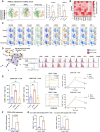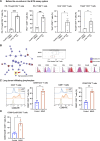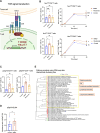Tetracyclines enhance antitumor T-cell immunity via the Zap70 signaling pathway
- PMID: 38621815
- PMCID: PMC11328671
- DOI: 10.1136/jitc-2023-008334
Tetracyclines enhance antitumor T-cell immunity via the Zap70 signaling pathway
Abstract
Background: Cancer immunotherapy including immune checkpoint inhibitors is only effective for a limited population of patients with cancer. Therefore, the development of novel cancer immunotherapy is anticipated. In preliminary studies, we demonstrated that tetracyclines enhanced T-cell responses. Therefore, we herein investigated the efficacy of tetracyclines on antitumor T-cell responses by human peripheral T cells, murine models, and the lung tumor tissues of patients with non-small cell lung cancer (NSCLC), with a focus on signaling pathways in T cells.
Methods: The cytotoxicity of peripheral and lung tumor-infiltrated human T cells against tumor cells was assessed by using bispecific T-cell engager (BiTE) technology (BiTE-assay system). The effects of tetracyclines on T cells in the peripheral blood of healthy donors and the tumor tissues of patients with NSCLC were examined using the BiTE-assay system in comparison with anti-programmed cell death-1 (PD-1) antibody, nivolumab. T-cell signaling molecules were analyzed by flow cytometry, ELISA, and qRT-PCR. To investigate the in vivo antitumor effects of tetracyclines, tetracyclines were administered orally to BALB/c mice engrafted with murine tumor cell lines, either in the presence or absence of anti-mouse CD8 inhibitors.
Results: The results obtained revealed that tetracyclines enhanced antitumor T-cell cytotoxicity with the upregulation of granzyme B and increased secretion of interferon-γ in human peripheral T cells and the lung tumor tissues of patients with NSCLC. The analysis of T-cell signaling showed that CD69 in both CD4+ and CD8+ T cells was upregulated by minocycline. Downstream of T-cell receptor signaling, Zap70 phosphorylation and Nur77 were also upregulated by minocycline in the early phase after T-cell activation. These changes were not observed in T cells treated with anti-PD-1 antibodies under the same conditions. The administration of tetracyclines exhibited antitumor efficacy with the upregulation of CD69 and increases in tumor antigen-specific T cells in murine tumor models. These changes were canceled by the administration of anti-mouse CD8 inhibitors.
Conclusions: In conclusion, tetracyclines enhanced antitumor T-cell immunity via Zap70 signaling. These results will contribute to the development of novel cancer immunotherapy.
Keywords: Drug Evaluation, Preclinical; Non-Small Cell Lung Cancer; T-Lymphocytes.
© Author(s) (or their employer(s)) 2024. Re-use permitted under CC BY-NC. No commercial re-use. See rights and permissions. Published by BMJ.
Conflict of interest statement
Competing interests: There are no competing interests.
Figures







Similar articles
-
Tetracyclines Enhance Anti-tumor T-Cell Responses Induced by a Bispecific T-Cell Engager.Biol Pharm Bull. 2022;45(4):429-437. doi: 10.1248/bpb.b21-00806. Biol Pharm Bull. 2022. PMID: 35370267
-
ILT4 inhibition prevents TAM- and dysfunctional T cell-mediated immunosuppression and enhances the efficacy of anti-PD-L1 therapy in NSCLC with EGFR activation.Theranostics. 2021 Jan 19;11(7):3392-3416. doi: 10.7150/thno.52435. eCollection 2021. Theranostics. 2021. PMID: 33537094 Free PMC article.
-
EGFR mutations induce the suppression of CD8+ T cell and anti-PD-1 resistance via ERK1/2-p90RSK-TGF-β axis in non-small cell lung cancer.J Transl Med. 2024 Jul 14;22(1):653. doi: 10.1186/s12967-024-05456-5. J Transl Med. 2024. PMID: 39004699 Free PMC article.
-
The Emerging Role of CD8+ Tissue Resident Memory T (TRM) Cells in Antitumor Immunity: A Unique Functional Contribution of the CD103 Integrin.Front Immunol. 2018 Aug 15;9:1904. doi: 10.3389/fimmu.2018.01904. eCollection 2018. Front Immunol. 2018. PMID: 30158938 Free PMC article. Review.
-
Recent Advances in Targeting CD8 T-Cell Immunity for More Effective Cancer Immunotherapy.Front Immunol. 2018 Jan 22;9:14. doi: 10.3389/fimmu.2018.00014. eCollection 2018. Front Immunol. 2018. PMID: 29403496 Free PMC article. Review.
Cited by
-
Cholestasis-induced phenotypic transformation of neutrophils contributes to immune escape of colorectal cancer liver metastasis.J Biomed Sci. 2024 Jun 29;31(1):66. doi: 10.1186/s12929-024-01052-3. J Biomed Sci. 2024. PMID: 38951890 Free PMC article.
References
MeSH terms
Substances
LinkOut - more resources
Full Text Sources
Medical
Research Materials
